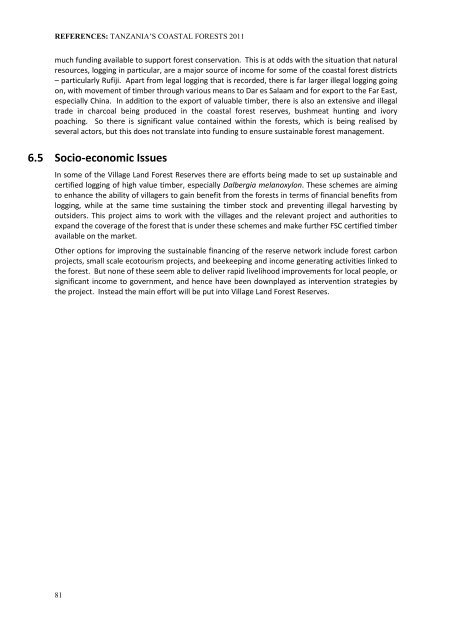Neil D. Burgess, Paul Harrison, Peter Sumbi, James Laizer, Adam ...
Neil D. Burgess, Paul Harrison, Peter Sumbi, James Laizer, Adam ...
Neil D. Burgess, Paul Harrison, Peter Sumbi, James Laizer, Adam ...
You also want an ePaper? Increase the reach of your titles
YUMPU automatically turns print PDFs into web optimized ePapers that Google loves.
REFERENCES: TANZANIA’S COASTAL FORESTS 2011<br />
much funding available to support forest conservation. This is at odds with the situation that natural<br />
resources, logging in particular, are a major source of income for some of the coastal forest districts<br />
– particularly Rufiji. Apart from legal logging that is recorded, there is far larger illegal logging going<br />
on, with movement of timber through various means to Dar es Salaam and for export to the Far East,<br />
especially China. In addition to the export of valuable timber, there is also an extensive and illegal<br />
trade in charcoal being produced in the coastal forest reserves, bushmeat hunting and ivory<br />
poaching. So there is significant value contained within the forests, which is being realised by<br />
several actors, but this does not translate into funding to ensure sustainable forest management.<br />
6.5 Socio-economic Issues<br />
In some of the Village Land Forest Reserves there are efforts being made to set up sustainable and<br />
certified logging of high value timber, especially Dalbergia melanoxylon. These schemes are aiming<br />
to enhance the ability of villagers to gain benefit from the forests in terms of financial benefits from<br />
logging, while at the same time sustaining the timber stock and preventing illegal harvesting by<br />
outsiders. This project aims to work with the villages and the relevant project and authorities to<br />
expand the coverage of the forest that is under these schemes and make further FSC certified timber<br />
available on the market.<br />
Other options for improving the sustainable financing of the reserve network include forest carbon<br />
projects, small scale ecotourism projects, and beekeeping and income generating activities linked to<br />
the forest. But none of these seem able to deliver rapid livelihood improvements for local people, or<br />
significant income to government, and hence have been downplayed as intervention strategies by<br />
the project. Instead the main effort will be put into Village Land Forest Reserves.<br />
81

















